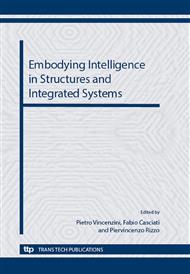p.115
p.122
p.132
p.138
p.144
p.151
p.157
p.167
p.177
Real-Time Smart Abstract Shape Identifiers
Abstract:
Smart structural systems are emerging as a vehicle for implementing semi active control algorithms. Sensors, processors and actuators are the generic basic components of any smart structural system. Sensors are employed in gathering information that could be used by a smart shape identifier in order to define a real-time abstract deformed shape of the system at any given point in time. This information could be employed in proposing a suitable smart control algorithm to suppress the vibration of a given structural system. In this paper, a generic framework for abstract shape identification is developed. The proposed framework employs predefined potential deformed patterns, for a given structural system, in training and/or designing the smart shape identifier. Two applications were developed which employ neural network and fuzzy logic as two potential smart technologies. Both models are capable of indentifying and/or classifying the abstract deformed shape of a three degree-of-freedom structural system in real-time. The neural network model was developed and trained by a single earthquake record then tested using five unseen earthquake records. The fuzzy inference system employed a rule-base that was developed to capture all potential combinations of inter-story deformations then tested using all six earthquake records. The performance of both models was measured by the statistical and geometrical properties of a linear compliance graph. The developed systems were initially designed and tested to model a three-degree-of-freedom system and are now being expanded to model a multi-degree-of-freedom system.
Info:
Periodical:
Pages:
144-150
Citation:
Online since:
September 2012
Authors:
Keywords:
Price:
Сopyright:
© 2013 Trans Tech Publications Ltd. All Rights Reserved
Share:
Citation:


